| ALEXANDER TECHNIQUE: The Musician's Resource
|
By Idelle Packer, MS, PT, CTAT
(certified teacher of the Alexander Technique)
|
While attracted to work that is satisfying, even exhilarating, musicians are vulnerable to posture-related or repetitive stress-related physical ailments such as chronic muscle and tendon ailments, and back and neck pain. These tendencies are compounded by stress of performance anxiety and internal and external pressures to excel in a highly competitive field.
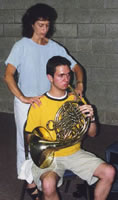 |
| John Kuhns, preparing to play horn in an Alexander lesson, Brevard Music Center, summer 2001. |
The Alexander Technique offers musicians practical skills for observing, identifying, and eliminating postural and muscular habits that produce excess tension, interfering with optimal performance.
 |
| Andy Earnest, euphonium player, advanced division musician at Brevard Music Center, summer 2003, utilizing the Alexander Technique. |
The experiential learning process allows the student to open the breathing mechanism, align the torso, revise poor movement patterns, and release unnecessary tension.
 |
| Idelle working with Asheville musician, Dawn Baker, participant in UNCA Music Department presentation on the Alexander Technique. |
The key is releasing tension, allowing greater freedom in the throat for voice projection or in the arms and torso for instrumental musicians to increase dexterity, breath, and expression.
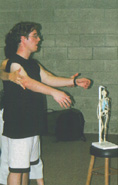  |
| Singer, Dan Hinson combining gesture and vocalization in his Alexander lesson, Brevard Music Center, summer 2001 |
With new-found proficiency at conscious control of the breath and patterns of muscular tension, the musician has tools to overcome mental stresses that may interfere with general coordination and performance.
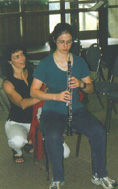 |
| Courtney Miller, Advanced Division, Brevard Music Center, summer 2001, receiving "direction" from Idelle before playing her oboe. |
In my work with musicians, singers, and conductors at the Brevard Music Center in North Carolina, I observed the rewards for the performing artist who studies the Alexander Technique: improved stance, comfort, and most importantly, physical and mental freedom in the complex discipline of practice and performance.
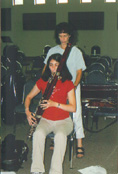 |
| Marisol Taub, bassoonist at Brevard Music Center, participating in a group class lead by Idelle, summer 2001 |
Seemingly subtle changes in the head, neck, back relationship can change the habitual approach to chinning a violin, fingering the cello, or bowing the strings of an upright bass, preventing harmful tension while enhancing the quality of the sound and the sensitivity and stamina of the string player.
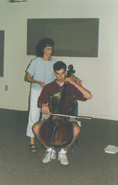 |
| Eric Jones, cellist, at Brevard music Center, summer 2001, taking a lesson in the Alexander Technique as applied to his cello concretizing. |
The singer or wind/brass player learns to integrate the breath and ease at the head and neck while producing fuller sound.
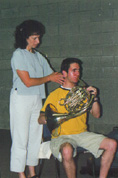 |
| John Kuhns, responding to the Alexander Technique while playing horn, Brevard Music Center, summer 2001. |
The pianist uses the Alexander Technique to discover greater ease/dexterity and sound quality when applying its principles to sitting posture, trunk motion, use of arms/wrists, and fingers at the piano.
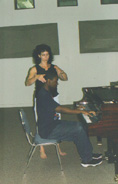 |
| Darius Johnson, young artist division of Brevard Music Center, summer 2001, applying the Alexander Technique to sitting with poise at the piano. |
The Alexander Technique's indirect approach of re-examining ordinary activity and then applying the same thought process to the physical demands of musicians, singers, and conductors offers essential skills for work on and off the stage. The greatest reward is hearing the change in the quality of performance. The body behind the instrument, balanced and poised, breathing and moveable, free of undue tension, is no longer interfering with the sound.
|


